“Each of our wines has a story that revolves around a vineyard or an appellation and a great winemaker.” —Matthew Smith, GrapeSeed
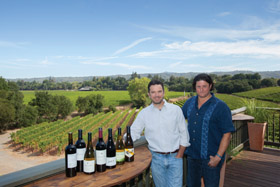 Robert Louis Stevenson once penned the words, “Wine is bottled poetry.” If that’s true, then the new startup winery, GrapeSeed, is on its way to becoming a literary success. GrapeSeed is an up-and-coming producer of inspired wines, created by world-class winemakers and delivered directly to consumers. And like poetry, each bottle of GrapeSeed wine has a story to tell and is an experience to be savored slowly.
Robert Louis Stevenson once penned the words, “Wine is bottled poetry.” If that’s true, then the new startup winery, GrapeSeed, is on its way to becoming a literary success. GrapeSeed is an up-and-coming producer of inspired wines, created by world-class winemakers and delivered directly to consumers. And like poetry, each bottle of GrapeSeed wine has a story to tell and is an experience to be savored slowly.In March, GrapeSeed Wine Fund launched, making small-production wines created by artisan winemakers. What’s more, GrapeSeed makes it possible for its members (known within the company as “partners”) to fund one-of-a-kind wine projects from its roster of iconic winemakers from Sonoma, Napa and beyond.
“The wine fund contributions that people make ‘seed’ the projects we create with partner winemakers,” explains Dave Trebilcock, founder and chief executive officer. And it’s the seed money they’re given for their projects that inspired the name of the Healdsburg-based company: The idea behind GrapeSeed is for partners to plant a seed, watch it grow and enjoy exclusive wines.
This unique business model avoids the more commonplace, three-tier distribution system and sells directly to its partners. “We want to bring luxury wines directly to consumers,” says Matthew Smith, a co-founder and vice president of winemaking and operations at GrapeSeed. “It turns the cash-flow model [of the wine industry] upside down and helps projects along.” (See “The Three-Tier System,” below.)
Seed of inspiration
Owning a vineyard is a dream shared by many entrepreneurs, but winemaking is a tough, competitive business. There’s year-round farmwork, environmental challenges, compliance issues when shipping out of state and wages to pay—not to mention the costs of bottles, labels, corks and other necessary items.
Today, the top 10 suppliers represent 77 percent of the U.S. wine market, according to a report from Adams Beverage Group. GrapeSeed was founded by a small team of industry insiders with a shared passion for artisan winemaking. Trebilcock founded the company with digital marketer Isaac Herrera, entrepreneur and venture capitalist Cameron Yuill and winemaker Matt Smith. Smith, formerly a winemaker at Kendall-Jackson, came on board in April, just as the company was taking shape. Smith and Trebilcock initially connected through their wives, Kimberly Riff and Jane Trebilcock, who met at a local park in 2004 where their young children liked to play.
The two men met later, and since they’d both built their careers around the wine industry, they had plenty to talk about. In 2012, Trebilcock invited Smith to his home, where they tasted wines and talked shop. It was that evening that the seed of inspiration for GrapeSeed took hold.
GrapeSeed Wine Fund
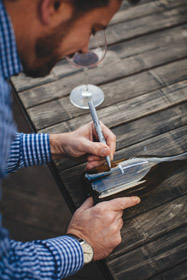 Traditionally, wine clubs include a single winemaker or winery, limited varieties of wine, predictable styles and set shipment dates. GrapeSeed offers an entirely different kind of wine club. It’s subscription-based, so you pay a monthly fee, which funds GrapeSeed winemakers’ creative projects. In exchange, GrapeSeed ships exclusive, small production wines directly to you—and, along the way, invites you to unique Wine Country excursions.
Traditionally, wine clubs include a single winemaker or winery, limited varieties of wine, predictable styles and set shipment dates. GrapeSeed offers an entirely different kind of wine club. It’s subscription-based, so you pay a monthly fee, which funds GrapeSeed winemakers’ creative projects. In exchange, GrapeSeed ships exclusive, small production wines directly to you—and, along the way, invites you to unique Wine Country excursions.“The depth of experiences and breadth of portfolio we’re taking on is totally new,” says Trebilcock.
“It’s unparalleled access to exclusive products,” adds Smith.
The company offers two partnership levels, standard and magnum. The basic, standard level requires a $49 per month contribution to a personal wine fund. All wine fund contributions act as a personal piggy bank, which can be used by the partner at any time to acquire wine. The magnum level is like Amazon Prime, offered at the standard monthly rate ($49) plus an additional $99 per year; it gives partners complimentary shipping on all orders, access to pre-release wines and pre-release prices as well as double loyalty points. Additionally, GrapeSeed partners can reserve experiences at participating wineries, which they “pay” for with loyalty points.
In June, for example, GrapeSeed held a wine-blending seminar for its partners, guided by winemaker Jean Hoefliger at Alpha Omega in the Rutherford District of Napa Valley. And in July, Jessica Boone, the winemaker for GrapeSeed’s “Eighteen Miles” wines, took partners on a cellar tour at Passalacqua Winery to taste the same wine from four different barrels, highlighting how different cooperages (the making of barrels and casks) and barrel toasting styles impact wine character. “Each wine was distinct,” says Smith. GrapeSeed is planning two events this fall to give partners insight and hands-on experience during harvest.
What’s unique about the wine club is that there are few rules to becoming a partner. What’s more, every dollar contributed to the wine fund is yours to spend. Partners can shop and buy the wines they want, anytime they want—there are no set shipments or schedules. That means, for example, a member could order the Sonoma Coast Chardonnay or the North Coast All-Stars Pinot Noir one month. Then, wait a month or two and splurge on five bottles of the Elementary Cabernet.
Currently, GrapeSeed has more than 150 partners participating in its wine fund, not only in California, but also in most states that allow direct shipping. Currently, Michigan and Colorado are two leading markets. And the startup winery is committed to bringing its partners fully into the process of winemaking by demystifying the process. “By being a GrapeSeed member, you’re a Wine Country insider,” says Smith. “And every event offers an educational component.”
A winemaker dream team
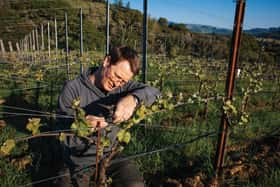 When the company launched earlier this year, Trebilcock and Smith assembled a dream team of winemakers, most from Napa and Sonoma. “People are seeking authenticity in wine,” says Trebilcock, who’s been in the wine business for more than 25 years. At GrapeSeed, “authenticity” means thoughtfully choosing the winemakers it works with. Currently, GrapeSeed is working with seven notable winemakers, and there will be more to come. (See “GrapeSeed Winemakers” below.)
When the company launched earlier this year, Trebilcock and Smith assembled a dream team of winemakers, most from Napa and Sonoma. “People are seeking authenticity in wine,” says Trebilcock, who’s been in the wine business for more than 25 years. At GrapeSeed, “authenticity” means thoughtfully choosing the winemakers it works with. Currently, GrapeSeed is working with seven notable winemakers, and there will be more to come. (See “GrapeSeed Winemakers” below.)“We approach winemakers to do a project,” explains Trebilcock. “We talk about what they want to make, what vineyard resources they have access to and how it will be different from both their own brand and the brands currently in GrapeSeed’s portfolio. Then we map it out, using a disciplined brand positioning framework, and work with the winemaker to create a unique identity for the brand.” Every brand must be authentic—meaning there’s a real winemaker, a story, great vineyard sources and an artisan approach. “If a brand falls short on any of these parameters, it won’t be made for GrapeSeed,” says Trebilcock.
“Each of our wines has a story that revolves around a vineyard or an appellation and a great winemaker,” adds Smith.
For example, the five wines produced by Boone for the Eighteen Miles label each comes from a distinct appellation within an 18-mile radius around the city of Healdsburg. The Pinot Noir is from Russian River Valley; the Zinfandel is from Dry Creek Valley; the Cabernet Sauvignon is from Alexander Valley; and the Petite Sirah is from the Rockpile District. The Sonoma Coast Chardonnay was sourced from the Sonoma Coast appellation.
“[The Eighteen Miles brand] speaks to the range and bounty of this region. I know of no other region that has this—all within such a small geographic area,” says Smith, who pauses to take a sip. “The Sonoma Coast Chardonnay has gorgeous flavors of stone fruit and citrus, brioche [toast flavor] and nice mineral notes. The label features a compass and topographic relief to symbolize the importance of geography, and a cue to the cartographer with the indicator of 15.2 miles WSW [West Southwest] to the exact spot where the grapes were grown.”
The inaugural wines for Elementary, developed by winemaker Nick Goldschmidt, include two single-vineyard Cabernet Sauvignons from Alexander Valley. Goldschmidt has multiple degrees (in engineering, horticulture, viticulture and enology) and close to two decades experience as a winemaker; he’s currently an independent winemaker and consultant to 25 wineries in five different countries and enjoys focusing on single vineyards in ideal locations.
“I think the name Elementary says it all,” he says. “This is wine taken back to the basic level—with a hands-off approach, noninvasive farming practices and the wine is made site-specifically.” The Lone Tree vineyard is one of the highest in Alexander Valley, he says, “so we have the later start to the season. It’s a little cooler, and the vineyard faces east and doesn’t get late afternoon sun. It’s also dry farmed. As a result, we have smaller berries and the intensity is amazing.”
Doug Stewart, grower and winemaker at Lichen Estate in Mendocino County, created North Coast All-Stars with GrapeSeed, sourcing fruit primarily from Anderson Valley to create a Pinot Noir and Pinot Gris. (However, Stewart doesn’t rule out creating wines from other parts of the North Coast, including Sonoma, Lake or even Napa county.) “I had a brand [like this] in mind for years, and GrapeSeed is a good launch pad for it,” says Stewart.
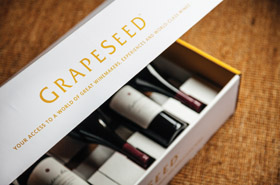 While Smith is currently spending more time helping to build the company and acquire new customers than he is making his own wine, he’ll definitely be making use of his skills after more than a decade with Kendall-Jackson. His upcoming wine project is to develop a brand with a nod to his family heritage in Marche, Italy, where his maternal grandparents once lived. Smith will develop a white wine and a Rosé from Italian grapes as well as a Cabernet-based blend using Sangiovese to give it a Tuscan-style flavor profile. The white and Rosé wines will be released in 2016, and the red wine will be released in 2017.
While Smith is currently spending more time helping to build the company and acquire new customers than he is making his own wine, he’ll definitely be making use of his skills after more than a decade with Kendall-Jackson. His upcoming wine project is to develop a brand with a nod to his family heritage in Marche, Italy, where his maternal grandparents once lived. Smith will develop a white wine and a Rosé from Italian grapes as well as a Cabernet-based blend using Sangiovese to give it a Tuscan-style flavor profile. The white and Rosé wines will be released in 2016, and the red wine will be released in 2017.The future of GrapeSeed
GrapeSeed’s winemaking style and business model is out-of-the-box creative, but its approach to reaching consumers is thoroughly planned and targeted. “We want to be a company that has a global portfolio,” says Trebilcock. “We want to be the one place to go to find great wines for passionate consumers.”
“We see GrapeSeed as a brand incubator for winemakers,” adds Smith. “And to create a new brand that partners and others start to ask for in restaurants. That’s an aspiration.”
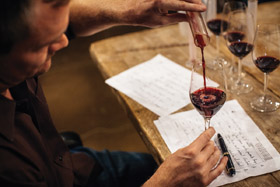 What’s the advantage to consumers? “The big difference is the quality you’re buying into,” says Goldschmidt. “[At GrapeSeed] you can follow a winemaker as much as you like, knowing he or she made the wine from start to finish.”
What’s the advantage to consumers? “The big difference is the quality you’re buying into,” says Goldschmidt. “[At GrapeSeed] you can follow a winemaker as much as you like, knowing he or she made the wine from start to finish.”“It’s a fun startup and they’re trying something new,” says Stewart. “[Dave and Matt] have fantastic ideas on how to treat partners who will get unique and great wines.”
As for Smith and Trebilcock, they’re focusing their efforts these days to give GrapeSeed a strong presence in the market.
“Matt may be one of the most underrated winemakers in the North Coast. His experience in winemaking is huge and GrapeSeed is his chance to shine and lead,” says Goldschmidt. “He’s been the guy behind the scenes on so many fine wines from Kendall-Jackson. Dave has been around a long time, too, and with his marketing and sales experience, he’s really helping customers get what they need. Together, they make up one of the strongest two-man teams in Wine Country.”
“There are more than 175,000 labels in wine,” says Trebilcock. “It’s a hard category to navigate. The lion’s share of the wine sold in mass channels is made by companies with big, sophisticated sales and marketing organizations. We think authenticity and artisanship is being lost. We’re going to be a trusted source for winemakers with a track record of critical success.”
GrapeSeed Winemakers
Currently, the GrapeSeed winemaking team includes seven critically acclaimed winemakers who bring a unique style to each of the wines they make.
Jessica Boone (Passalacqua Winery) started in the business as a harvest intern and learned every job, from driving a forklift to making small lot Bordeaux varietals. For Boone, winemaking is about creating, discovering and continually learning.
Nick Goldschmidt (Goldschmidt Vineyards) has a background in horticulture and is committed to hands-on, site-specific farming. He enjoys focusing on single vineyards in ideal locations.
Jean Hoeflinger (Alpha Omega Winery) launched Pact(e) and enjoys working with GrapeSeed because there are few limitations. The winemaking world can be a little conservative, he says, and GrapeSeed lets winemakers break out creatively.
Ed Sbragia (Sbragia Family Vineyards) is a third-generation winemaker, whose legacy involves 30 years at Beringer (where he remains winemaster emeritus). Ed creates wines from grapes that are fully extracted with as little intervention as possible. As he puts it, “I like to say, ‘What Mother Nature giveth, I taketh.’”
Adam Sbragia (Ed’s son) is a fourth-generation winemaker in Dry Creek Valley. His favorite wine was his grandfather’s, which was made in a barrel at the back of the family barn and served in carafes with prosciutto, salami, cheese and bread. Says Adam, “I’m happy to make wines that remind me of the ones we made at home.”
Doug Stewart (Lichen Estate) was making organic sorbet and gelato with a factory in San Francisco when he switched professions, bought a 203-acre farm in Anderson Valley and started Breggo Cellars in 2005. Robert Parker once said of Stewart, “No one makes a better Pinot Gris in this country.”
Matt Smith (formerly with Kendall-Jackson) has a track record for producing critically acclaimed wines. More than 20 of his red wines have received scores of 90 points or higher from Parker’s Wine Advocate, and critical acclaim and 90+ point scores from The Wine Enthusiast, Wine & Spirits and Vinous Media.
The Three-Tier System
The three-tier system of alcohol distribution was set up in the United States after Prohibition. The three tiers are producers, distributors and retailers.
Producers can sell their products only to wholesale distributors, who then sell to retailers. Only retailers may sell to consumers. (Producers include winemakers, brewers, distillers and importers.)
Some states chose to become alcoholic beverage control jurisdictions after Prohibition in 1920. In these states, part or all of the distribution tier—and sometimes also the retailing tier—are operated by the state government itself (or by contractors operating under its authority) rather than by independent private entitities. The only state with a privately operated retailing and distribution system that doesn’t require any form of three-tier system is the state of Washington.
Did You Know?
In 2013 and 2014, consumers exhibited a preference for more premium wines in the off-trade, with nearly every style of wine experiencing growth in higher-priced bands and declines in the lowest, according to Euromonitor International. The shift in consumption results from consumer confidence in the economy, the general trend in premium wines and a growth in product availability of mid-priced wines, creating a bridge for consumers who want to develop a more sophisticated palate at an affordable price.
Direct-To-Consumer Wine Market
The direct-to-consumer (DTC) wine market experienced a banner year in 2014. Here are a few facts:
• The total value of the winery DTC shipping channel increased 15.5 percent over 2013 and increased $1.82 billion in sales;
• Total volume of wine shipped increased 13.6 percent to 3.95 million cases;
The average price per bottle of wine shipped increased 1.6 percent to $38.40 in 2014;
• The DTC channel grew four times as fast as traditional off-premise channels; and
• Highest-priced wineries experienced the biggest growth while smaller wineries (5,000 to 49,999 cases) saw the most growth in average bottle price.
Source: 2015 Direct to Consumer Shipping Report by ShipCompliant and Wines & Vines.
Author
-

Karen Hart is the editor of NorthBay biz magazine, keeping her finger on the pulse of the North Bay, directing content and leading day-to-day operations of the editorial team. An award-winning writer, Karen brings more than 30 years of experience to the position. She is a member of the California Writers Club, and serves on the Journalism Advisory Council at Santa Rosa Junior College. She moved to Sonoma County in 2000, and she’s here to stay.
View all posts



